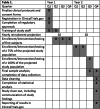Telehealth high-intensity interval exercise and cardiometabolic health in spinal cord injury
- PMID: 35927708
- PMCID: PMC9351173
- DOI: 10.1186/s13063-022-06585-2
Telehealth high-intensity interval exercise and cardiometabolic health in spinal cord injury
Abstract
Background: The number of exercise trials examining cardiometabolic outcomes in spinal cord injury (SCI) is low, and prescribed exercise is often inconvenient for individuals with SCI to perform within their community. Individuals with SCI experience a myriad of barriers to exercise participation, which can include a lack of time, accessible or usable equipment and facilities, and transportation. Thus, it is imperative to identify effective modes of exercise that provide the greatest overall health benefits but do not require a significant time commitment. Low-volume high intensity interval training (HIIT) has demonstrated the same improvements in cardiometabolic health as moderate intensity exercise training (MIT), despite only requiring 20% of the total time commitment in adults without disabilities and more recently in individuals with SCI.
Objectives: The primary purpose of this study is to integrate a 16 week home-based telehealth HIIT arm crank exercise training program in individuals with SCI and assess changes in cardiometabolic health.
Methods: Men and women between the ages of 19 and 60 with a confirmed diagnosis of SCI between C7 and T12 will be recruited for this study. Participants will be randomized to 16 weeks of telehealth HIIT exercise two days per week or a no-exercise control group. Aerobic capacity, muscular strength, blood lipids, glucose tolerance, resting energy expenditure, blood pressure, and body composition will be assessed at baseline and 16 weeks post-training.
Discussion: Inactivity associated with SCI leads to chronic cardiometabolic health conditions. The majority of exercise interventions to date show that exercise is capable of increasing physical function, aerobic capacity, and muscle mass, and strength. Additionally, we have recently shown the ability of HIIT to improve blood lipid and glucose concentrations. Advances in telehealth exercise approaches have improved the capability to prescribe home-based exercise programs. Therefore, we hypothesize that the utilization of a home-based telehealth HIIT program will improve cardiometabolic health markers, yield high adherence (> 75%), and will be more enjoyable in individuals with SCI.
Trial registration: Telehealth High-Intensity Interval Exercise and Cardiometabolic Health in Spinal Cord Injury NCT04940598.
Keywords: Exercise; HIIT; High-intensity interval training; Randomized controlled trial; Resistance training; SCI; Spinal cord Injury; Upper-body exercise.
© 2022. The Author(s).
Conflict of interest statement
No competing interests to declare.
Figures


Similar articles
-
Effects of High-Intensity Interval Training Versus Moderate-Intensity Training on Cardiometabolic Health Markers in Individuals With Spinal Cord Injury: A Pilot Study.Top Spinal Cord Inj Rehabil. 2019 Summer;25(3):248-259. doi: 10.1310/sci19-00042. Epub 2019 May 16. Top Spinal Cord Inj Rehabil. 2019. PMID: 31548792 Free PMC article. Clinical Trial.
-
Influence of upper-body continuous, resistance or high-intensity interval training (CRIT) on postprandial responses in persons with spinal cord injury: study protocol for a randomised controlled trial.Trials. 2019 Aug 13;20(1):497. doi: 10.1186/s13063-019-3583-1. Trials. 2019. PMID: 31409383 Free PMC article.
-
Effect of high-intensity interval training on cardiometabolic component risks in persons with paraplegia: Protocol for a randomized controlled trial.Exp Physiol. 2021 May;106(5):1159-1165. doi: 10.1113/EP089110. Epub 2021 Mar 20. Exp Physiol. 2021. PMID: 33600014
-
Benefits and interval training in individuals with spinal cord injury: A thematic review.J Spinal Cord Med. 2022 May;45(3):327-338. doi: 10.1080/10790268.2021.2002020. Epub 2021 Dec 2. J Spinal Cord Med. 2022. PMID: 34855568 Free PMC article. Review.
-
Intervention Design of High-Intensity Interval Training in Individuals With Spinal Cord Injury: Narrative Review and Future Perspectives.Top Spinal Cord Inj Rehabil. 2023 Fall;29(4):1-15. doi: 10.46292/sci22-00045. Epub 2023 Dec 1. Top Spinal Cord Inj Rehabil. 2023. PMID: 38076494 Free PMC article. Review.
Cited by
-
The impact of high-intensity interval training on women's health: A bibliometric and visualization analysis.Medicine (Baltimore). 2024 Sep 27;103(39):e39855. doi: 10.1097/MD.0000000000039855. Medicine (Baltimore). 2024. PMID: 39331945 Free PMC article.
-
Implementing Activity-Based Therapy for Spinal Cord Injury Rehabilitation in Canada: Challenges and Proposed Solutions.Healthcare (Basel). 2024 Mar 22;12(7):703. doi: 10.3390/healthcare12070703. Healthcare (Basel). 2024. PMID: 38610126 Free PMC article. Review.
-
Community-Based Exercise Programs Post Spinal Cord Injury Hospitalization: A Pilot Study for a Randomized, Multicenter, Double-Blind Controlled Setting.Life (Basel). 2024 Sep 9;14(9):1135. doi: 10.3390/life14091135. Life (Basel). 2024. PMID: 39337918 Free PMC article.
-
Pilot Study of Home-Based Virtual Reality Fitness Training in Post-Discharge Rehabilitation for Patients with Spinal Cord Injury: A Randomized Double-Blind Multicenter Trial.Life (Basel). 2024 Jul 9;14(7):859. doi: 10.3390/life14070859. Life (Basel). 2024. PMID: 39063613 Free PMC article.
References
-
- Lee BB, Cripps RA, Fitzharris M, Wing PC. The global map for traumatic spinal cord injury epidemiology: update 2011, global incidence rate. Spinal Cord. 2014;52(2):110–6. - PubMed
-
- National Spinal Cord Injury Statistical Center, Facts and Figures at a Glance. Birmingham, AL: University of Alabama at Birmingham; 2021.
-
- Ginis KA, Latimer AE, Arbour-Nicitopoulos KP, Buchholz AC, Bray SR, Craven BC, Hayes KC, Hicks AL, MA MC, Potter PJ, Smith K. Leisure Time Physical Activity in a Population-Based Sample of People With Spinal Cord Injury Part I: Demographic and Injury-Related Correlates. ACRM. 2010;91(5):722–728. - PubMed
Publication types
MeSH terms
Substances
Associated data
Grants and funding
LinkOut - more resources
Full Text Sources
Medical
Miscellaneous

